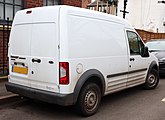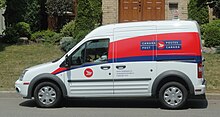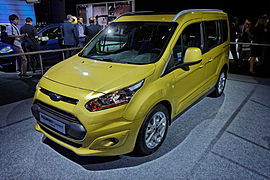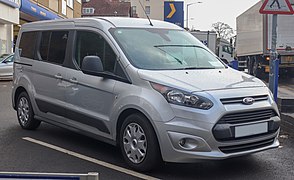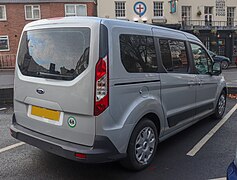
A van is a type of road vehicle used for transporting goods or people. Depending on the type of van, it can be bigger or smaller than a pickup truck and SUV, and bigger than a common car. There is some variation in the scope of the word across the different English-speaking countries. The smallest vans, microvans, are used for transporting either goods or people in tiny quantities. Mini MPVs, compact MPVs, and MPVs are all small vans usually used for transporting people in small quantities. Larger vans with passenger seats are used for institutional purposes, such as transporting students. Larger vans with only front seats are often used for business purposes, to carry goods and equipment. Specially equipped vans are used by television stations as mobile studios. Postal services and courier companies use large step vans to deliver packages.

The Ford Windstar is a minivan that was produced and sold by Ford. The replacement for the Ford Aerostar, the Windstar adopted the front-wheel drive configuration of the Chrysler minivans. From the 1995 to 2007 model years, three generations of the model line were sold, with the final generation renamed as the Ford Freestar.

The Ford Transit is a family of light commercial vehicles manufactured by the Ford Motor Company since 1965, primarily as a cargo van, but also available in other configurations including a large passenger van, cutaway van chassis, and a pickup truck. The vehicle is also known as the Ford T-Series, a nomenclature shared with Ford's other light commercial vehicles, the Ford F-Series trucks, and the Ford E-Series chassis. As of 2015, 8 million Transit vans have been sold, making it the third best-selling van of all time and has been produced across four basic platform generations, with various "facelift" versions of each.

The Ford Explorer is a range of SUVs manufactured by Ford Motor Company since the 1991 model year. As the first four-door SUV produced by Ford, the Explorer was introduced as a replacement for the two-door Bronco II. Within the current Ford SUV range in North America, the Explorer is slotted between the Ford Edge and Ford Expedition. As with the Ford Ranger, the Explorer derives its name from a trim package previously offered on the Ford F-Series pickup trucks.

The Volkswagen Caddy is a panel van and leisure activity vehicle (M-segment) produced by the German automaker Volkswagen Group since 1980. It is sold in Europe and in other markets around the world. The Volkswagen Caddy was first introduced in North America in 1980 and in Europe in 1982. The first and second generations also had pick-up variants.

The Mazda Bongo, also known as Mazda E-Series and the Ford Econovan, is a cabover van and pickup truck manufactured by the Japanese automobile manufacturer Mazda since 1966. The Bongo name was also used for the Bongo Friendee, which is not a cabover design.

The Ford Escape is a compact crossover SUV manufactured and marketed by Ford Motor Company since the 2001 model year. The first Ford SUV derived from a car platform, the Escape fell below the Ford Explorer in size; the Escape is currently sized between the Ford EcoSport and Ford Edge. The 2004 Ford Escape Hybrid was the first hybrid-electric vehicle from Ford, and the first hybrid produced as an SUV.
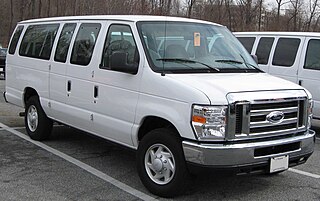
The Ford E-Series is a range of full-size vans manufactured and marketed by the Ford Motor Company. Introduced for 1961 as the replacement of the Ford F-Series panel van, four generations of the model line have been produced. Marketed for both cargo and passenger transport configurations, the E-Series has been designed with multiple design variations for both retail and commercial sale, including vans, and commercial-grade cutaway van chassis and stripped chassis.

The Ford Expedition is a full-size three-row SUV, manufactured by Ford Motor Company. Introduced for the 1997 model year as the successor of the Ford Bronco, the Expedition was the first full-size Ford SUV sold with a four-door body. For its entire production life, the Ford Expedition has been derived from the corresponding generation of the Ford F-series in production, sharing some body and mechanical components. The fourth-generation Ford Expedition began production for the 2018 model year. Similar to the configuration of the Chevrolet Tahoe and Chevrolet Suburban, the Ford Expedition is sold in regular and extended lengths ; sold since 2007, the latter functionally serves as the replacement for the Ford Excursion.

The Ford Excursion is a heavy-duty SUV that was sold by Ford Motor Company from 2000 to 2005. At the time of its introduction, the Excursion was the longest and heaviest SUV ever to enter mass production. The third Ford SUV derived from the F-Series pickup trucks, the model line used a heavier-duty chassis and frame than the Expedition; both vehicles competed against the Chevrolet Suburban.

The Ford Aerostar is a range of vans that was manufactured by Ford from the 1986 to the 1997 model years. The first minivan produced by Ford, the model line was marketed against the Chevrolet Astro/GMC Safari and the first two generations of the Chrysler minivans. Introduced shortly before the Ford Taurus, the Aerostar derived its name from its slope-nosed "one-box" exterior.

Ford Courier is a model nameplate used by Ford since the early 1950s. The Courier moniker has been used on a variety of vehicles all around the world since it was first used in North America for a sedan delivery. The Courier nameplate was also used by Ford for a series of compact pickup trucks and would also see use by Ford of Europe denoting a Fiesta-based panel van. Ford Brazil used the nameplate for a Fiesta-based coupe utility pickup marketed across Latin America.

The Ford Ranger is a range of pickup trucks manufactured and marketed by Ford Motor Company in North and South America under the Ford Ranger nameplate. Introduced in early 1982 for the 1983 model year, the Ranger is currently in its fourth generation. Developed as a replacement for the Mazda-sourced Ford Courier, the model line has been sold across the Americas; Ford of Argentina began production of the Ranger for South America in 1998.

The Mercedes-Benz Sprinter is a light commercial vehicle (van) built by Mercedes-Benz Group AG of Stuttgart, Germany as a large van, chassis cab, minibus, and pickup truck. In the past, the Sprinter had been sold under the Mercedes-Benz, Dodge, and Freightliner nameplates. In the U.S., it was built from complete knock down (CKD) kits by Freightliner. Re-badged and re-engined Sprinters were also sold by Volkswagen Commercial Vehicles as the Volkswagen LT and the Volkswagen Crafter. They are now primarily marketed by Mercedes-Benz.

The Fiat Doblò is a panel van and leisure activity vehicle produced by Italian automaker Fiat since 2000. It was unveiled at the Paris Motor Show in October 2000. A second-generation Doblò succeeded the original vehicle in 2010 for most markets, and it was sold in the United States as the RAM ProMaster City from 2015 to 2022. The second generation was also sold in Europe and the UK as the Opel/Vauxhall Combo. The third-generation Doblò, a rebadged version of the Citroën Berlingo, was unveiled in June 2022, and is also sold as the Opel or Vauxhall Combo, Peugeot Partner, and Toyota ProAce.

A panel van, also known as a blind van, car-derived van or sedan delivery, is a small cargo vehicle with a passenger car chassis, typically with a single front bench seat and no side windows behind the B-pillar. Panel vans are smaller than panel trucks or cargo vans, both of which use body-on-frame truck chassis.

The Daihatsu Hijet is a cab over microvan and kei truck produced and sold by the Japanese automaker Daihatsu since 1960. Despite the similarities between the Hijet name and Toyota's naming scheme for its trucks and vans, the name "Hijet" has been in use for Daihatsu's kei trucks and microvans since 1960, over two decades before Toyota took control. "Hijet", when transliterated into Japanese, is very similar to "Midget", one of Daihatsu's other mini-trucks. According to Daihatsu, the name "Hijet" was created to imply that the vehicle offers higher performance than the Midget. The Hijet competes in Japan with the Honda Acty, Mitsubishi Minicab, Nissan Clipper, Subaru Sambar and Suzuki Carry.

The Mitsubishi Delica is a range of vans and pickup trucks designed and built by the Japanese automaker Mitsubishi Motors since 1968. It was originally based on a cabover van and pickup truck introduced the previous year, also called the Delica, its name a contraction of the English language phrase Delivery car. This pickup truck, and a commercial van derived from it has received many names in export markets, being sold as the L300 in Europe, Jamaica and New Zealand, Express and Starwagon in Australia, and plain Mitsubishi Van and Wagon in the United States. The passenger car versions were known as Delica Star Wagon from 1979 until the 1994 introduction of the Delica Space Gear, which became simply Space Gear in Europe at least. The most recent version is called the Delica D:5. With the exception of the first, versions of all generations are still being sold in various international markets.

The Ford Transit Courier is a small delivery vehicle marketed by Ford of Europe. Making its debut as a model of 2014 at the 2013 Geneva Motor Show, the Transit Courier is the smallest vehicle of the product range of the Ford Transit. Deriving its underpinnings from the Ford Fiesta, the model line is the first van based on the Fiesta, since the discontinuation of the Ford Courier in August 2002. The Tourneo Courier variant is marketed as leisure activity vehicle.

The Ford Transit Custom is a mid-sized, front wheel drive van produced by Ford Europe since 2012. It marked a split in the Transit range, with the Custom being the smaller version and the Ford Transit being the larger. Similar to other Transit variants, the passenger versions were branded Tourneo Custom.






